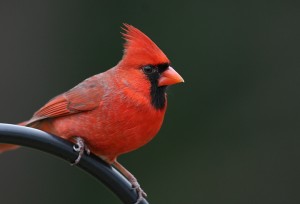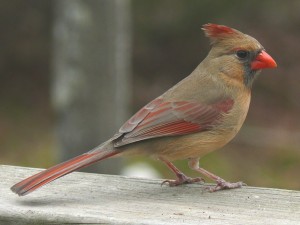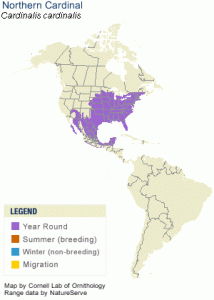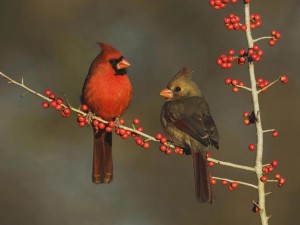Appearance: The northern cardinal is fairly large with a length of about 8.3 to 9.1 inches. This bird features a long tail with a short and thick bill. The northern cardinal is an example of sexual dimorphism as the male is bright red with a black face and red bill, while the female is a brownish color with red on the crest, wings and tail.
Social Behavior: Northern Cardinals hop through low branches and forage on or near the ground and commonly sing and preen from a high branch. Overall, the cardinal exhibits aggressive behavior.
Breeding Behavior: You typically see cardinals moving around in pairs during the breeding season, but in fall and winter cardinals can form fairly large flocks of a dozen to several dozen birds. Pairs may stay together throughout winter, but up to 20 percent of pairs split up by the next season. Overall the northern cardinal is a monogamous species. Males are very territorial over breeding area, and will fight other males who enter area. The average clutch size is 3 to 4 eggs and the red color of the cardinal is sexually selected for. In simple terms, the redder the bird, the better.
Habitat: The northern cardinal prefers open woodlands as its habitat. Dense shrubby areas such as forest edges, overgrown fields, hedgerows, backyards, marshy thickets, mesquite, and regrowing forest are all common areas that cardinals are found. Growth of towns and suburbs across eastern North America has helped the cardinal expand its range northward and populations of this bird are of least concern and are growing. The northern cardinal is a nonmigratory bird that is found throughout a large portion of North America.
Foraging: They eat mainly seeds and fruit such as dogwood, wild grape, buckwheat, grasses, sedges, mulberry, hackberry, blackberry, sumac, tulip-tree, and corn. The cardinal will supplement these seeds and fruits with insects such as beetles, crickets, katydids, leafhoppers, cicadas, flies, centipedes, spiders, butterflies, and moths. Cardinals also eat many kinds of birdseed but prefer black oil sunflower seed.




